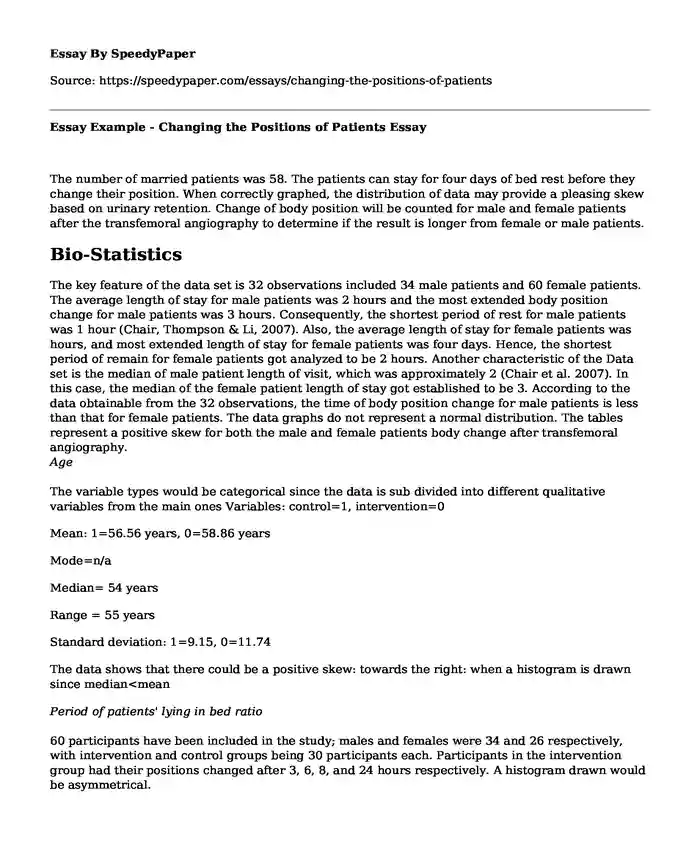The number of married patients was 58. The patients can stay for four days of bed rest before they change their position. When correctly graphed, the distribution of data may provide a pleasing skew based on urinary retention. Change of body position will be counted for male and female patients after the transfemoral angiography to determine if the result is longer from female or male patients.
Bio-Statistics
The key feature of the data set is 32 observations included 34 male patients and 60 female patients. The average length of stay for male patients was 2 hours and the most extended body position change for male patients was 3 hours. Consequently, the shortest period of rest for male patients was 1 hour (Chair, Thompson & Li, 2007). Also, the average length of stay for female patients was hours, and most extended length of stay for female patients was four days. Hence, the shortest period of remain for female patients got analyzed to be 2 hours. Another characteristic of the Data set is the median of male patient length of visit, which was approximately 2 (Chair et al. 2007). In this case, the median of the female patient length of stay got established to be 3. According to the data obtainable from the 32 observations, the time of body position change for male patients is less than that for female patients. The data graphs do not represent a normal distribution. The tables represent a positive skew for both the male and female patients body change after transfemoral angiography.
Age
The variable types would be categorical since the data is sub divided into different qualitative variables from the main ones Variables: control=1, intervention=0
Mean: 1=56.56 years, 0=58.86 years
Mode=n/a
Median= 54 years
Range = 55 years
Standard deviation: 1=9.15, 0=11.74
The data shows that there could be a positive skew: towards the right: when a histogram is drawn since median<mean
Period of patients' lying in bed ratio
60 participants have been included in the study; males and females were 34 and 26 respectively, with intervention and control groups being 30 participants each. Participants in the intervention group had their positions changed after 3, 6, 8, and 24 hours respectively. A histogram drawn would be asymmetrical.
Describe the key features of the data set.
There were 60 observations where intervention and control groups had 30 each.
The participants, all of them married, were 18-65 years old and had less than 180/100 mm Hg as blood pressure (Valiee et al. 2016).
Intervention groups had their positions changed 3, 6, 8, and 24 hours after trans femoral angiography
The intervention group was subjected to 45, 15, and 15 elevations after 3, 5, and 6 hours of trans femoral angiography, respectively (Valiee et al., 2016).
For the intervention group, there were 22 males and 8 females, while for the control group, there were 12 males and 18 females.
22 of the participants were illiterate, 7 under diploma and 1 of diploma level of education.
2 of the participants were clerks, 19 self-employed, 3 retired, and 6 as housewives, 17 dad smoking history, while 13 had no smoking history (Valiee et al., 2016).
1 patient had angiography history, while 29 had none.
The catheter sizes F4, F5, F6, and F7 were used for 1, 1, 20, and 8 patients, respectively.
All the participants had rapture of the femoral artery.
Meglumine and visipague contrast media were used for 14 and 16 patients, respectively.
NECA, 1VD, 2VD, and 3VD disease diagnoses were registered in 10, 2, 12, and 6 participants, respectively (Valiee et al., 2016).
RCA, LMCA, LAD, and LCX significance stenosis of coronary arteries were in 9, 1, 14, and 4 patients, respectively.
Analyze the limitations of the data set.
In the study, there was the use of a supine position for the participants in the control group, while the intervention group had their positions altered periodically. It was then concluded that changing the positions of patients improved their comfort in comparison to the patients in supine positions. However, there was no study inclusion for patients in prone position before the conclusion of the patients in recommended sleeping positions was made. Also, the periods for changing the sleeping positions for the intervention group was not even; there should have been the use of evenly distributed time frames for standard results to be obtained. The impacts of early ambulation were not analyzed and the duration of keeping the sandbag on catheter insertion (Valiee et al., 2016). Finally, there was not an analysis of the use of sandbags with varying weights on the incidence of chronic complications at different time points in the study.
References
Valiee, S., Fathi, M., Hadizade, N., Roshani, D., & Mahmoodi, P. (2016). Evaluation of feasibility and safety of changing body position after transfemoral angiography: A randomized clinical trial. Journal of Vascular Nursing, 34(3), 106-115.
Cite this page
Essay Example - Changing the Positions of Patients. (2023, Mar 22). Retrieved from https://speedypaper.net/essays/changing-the-positions-of-patients
Request Removal
If you are the original author of this essay and no longer wish to have it published on the SpeedyPaper website, please click below to request its removal:
- Personal Philosophy of Nursing, Essay Sample for Free Use
- Free Essay That Answers What Makes a Person Admirable?
- International Petroleum Investment Company and Technology. Essay Example.
- Saudi Arabia Case Study Example
- Education Essay Example: ELL Language Policies
- People Addiction to the Internet
- Essay Sample on Global Financial Meltdown
Popular categories





